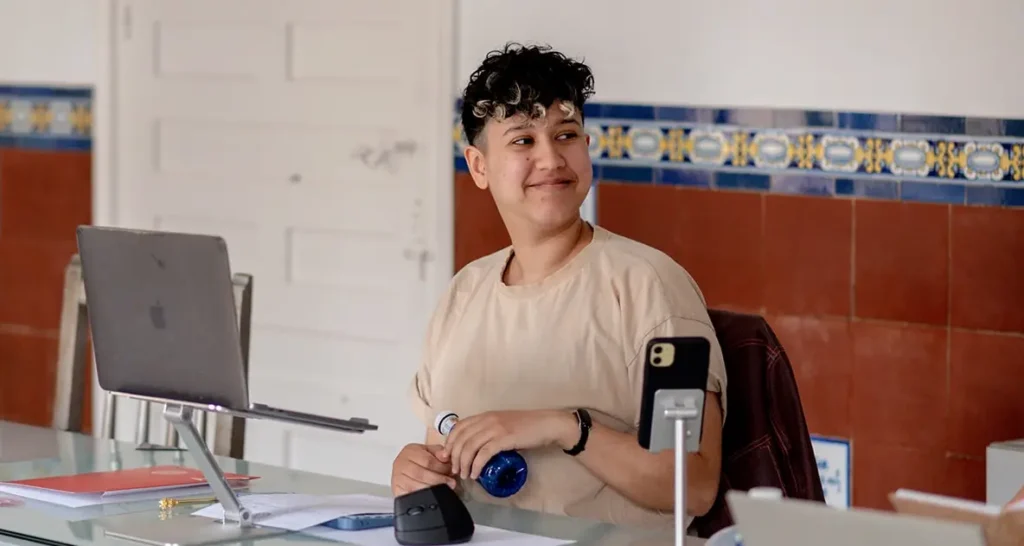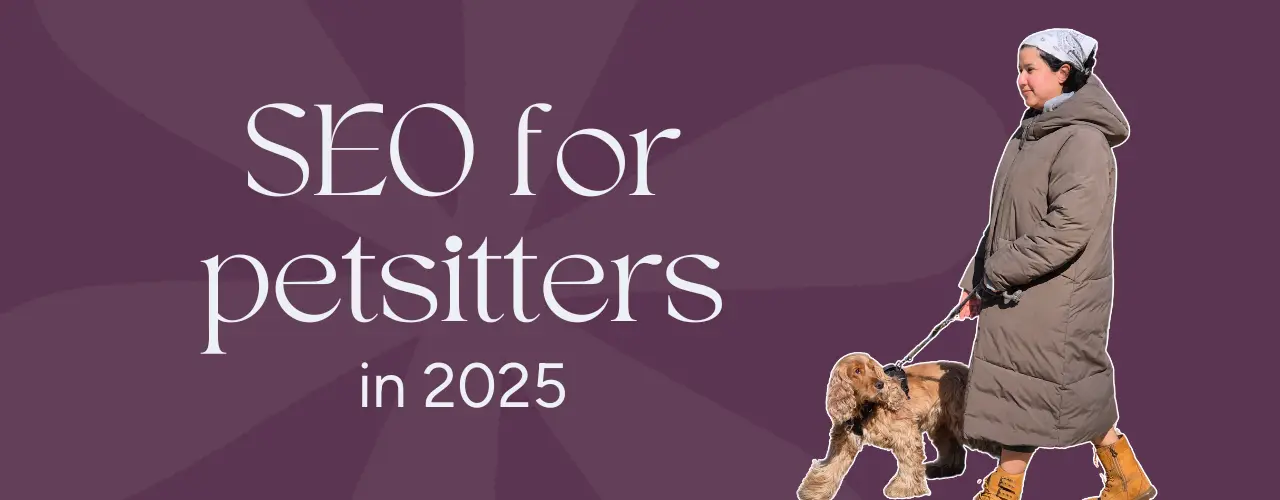Last updated: 23 April, 2025 | Estimated reading time: 12 min read
What exactly is SEO for pet sitters—and do you really need it to grow your pet care business?
For a lot of pet parents, their furry little buddies are more than just pets—they’re family. That’s why they only choose pet sitters they truly trust. As a former fur parent myself, let me tell you, I know. So when pet parents search for something like “pet sitters near me,” they’re not just looking for someone nearby—they’re looking for someone who’s reliable, caring, and trustworthy.
That’s where SEO for pet care businesses comes in, and it’s definitely part of the list of pet business marketing tips that you’ll want to follow. If you’re new to the pet care business, building a strong online presence can make a huge difference in attracting clients. It’s all about showing up where people are searching and showing yourself as a capable, compassionate pet sitter they can count on.
Now, SEO might seem a little overwhelming—especially if you’re self-employed and juggling pretty much everything, including marketing your business. But don’t worry! This blog post is here to break things down in a simple way so you can understand SEO for pet sitters better and pick up a few tips to get more visibility for pet services like yours.
Why SEO for pet sitters is actually worth the effort
If you’re a pet sitter trying to grow your business online, SEO isn’t just for big brands or agencies. It’s for you too. And you don’t have to spend thousands—or even hundreds—to make it work.

It can be intimidating, but a good long-term strategy to use SEO as a pet sitter is to understand your local audience, choose the right keywords, and create relevant and relatable content. Let’s break these down a bit more so you can get a clearer idea of what your SEO game plan might look like.
Understand your local audience with SEO
When you’re a pet sitter, your first clients won’t be pet owners who are living across the city but rather those who are near to you. This is why local SEO for pet sitters is a big deal for your business.
But what is local SEO? (We’ll discuss more about this next!) Basically, this is an SEO strategy that focuses on improving a business’s online visibility in its target local area. For example, if you’re a pet sitter in New York City, you want to target pet parents who are within the area.
To do this, you have to understand your target audience and think about what they are searching for. Are they looking for dog walkers or overnight pet sitters? Or do they need cat sitting services? The better you understand your audience’s needs, the more targeted your content will be.
One of the simple and most important SEO tips for dog walkers and pet sitters is to make sure you mention your city or service area throughout your site. You want people to know you’re nearby and available to take care of their pets.

Use the right SEO keywords
Keywords remain an important element in a good SEO strategy. These are phrases people type into search engines when they’re looking for services. Think of it as something like “pet sitters in France”, “dog walkers near me”, or “pet sitters overnight”.
So what you can do is to add these keywords naturally in your website copy, page titles, and even blog posts. This way, Google and other search engines will associate your website with these types of content.
A lot of beginners hear about keywords and end up “keyword stuffing”—basically cramming their target phrases all over their site in a way that feels super forced. Trust me, that can actually do more harm than good. Google’s pretty smart, and it favors content that sounds natural. So when you’re using your keywords, just work them in like you’re having a normal conversation.
Mention the services you offer
Another great pet sitter web optimization tip you can do to help potential clients get to know you better is by clearly listing all the services you offer. It’s not just helpful for pet parents—Google loves that kind of clarity too.
Creating a separate page for each service (like dog walking, pet sitting, or overnight care) gives you space to explain how it works, what you charge, and what clients can expect. You can even add photos of happy, furry clients you’ve worked with! It’s a great way to build trust and show people that your services are both real and pet-approved.
Build trust through clear, genuine content
Trust is everything when it comes to pet care. As a former pet parent myself, I totally get it—you only want someone you really trust looking after your furry friend. And this is something that you should invest in if you want to make your service more visible online.
Your website should sound like you—not some generic advertisement they’ll read online. Make content that shares your experiences as a pet owner and sitter and your love for animals. This personal touch will help people to connect with you, which will help you book more clients.
You can also include a few client testimonials to show how other pet owners have enjoyed and been satisfied with your services.

Choose a CMS that gives you room to grow
A lot of people think that having a cute, good-looking website is all it takes to show up at the top of Google searches—but sadly, that’s not the case. There’s a lot more that goes into ranking well, and it’s not just about how your site looks. So when you’re picking a Content Management System, make sure to consider more than designs and aesthetics. You’ll want something that’s SEO-friendly, flexible, and built to grow with your business.
There are tons of popular CMS options out there—some even come with super user-friendly drag-and-drop editors, which can be great if you’re just starting out. But personally, I found that WordPress worked best for me. It gives me way more control over the SEO tools and features I need to help my site grow.
I’ve also written a few blog posts where I dive into the pros and cons of different CMS platforms like Wix, Squarespace, Framer, and WordPress. If you’re still undecided or thinking about switching platforms, feel free to check those out—they might help you figure out what might work best for you.
What local SEO can do for your pet care website
Whether you’re just starting out or ready to upgrade from an app-based profile, your own website and a focus on local SEO can be the competitive edge you need to outrank the other pet sitters in your area.
So, if you’ve been wondering, “How to rank my pet care website on Google?” and you’re looking for concrete steps to get noticed in local searches—don’t worry, I’ve got you covered! Here are some simple local SEO tips to help boost your visibility:

- Use location-based keywords — Use keywords that include your city or neighborhood on your homepage, service pages, and blog content.
- Add your location to meta descriptions — A meta description is a short blurb that shows under your page title in search results and gives readers a sneak peek of what your page is about. You want to make sure that your target area is mentioned there too.
- Create a dedicated “Service Area” or “Location” page — If you’re serving multiple areas, you’d want to create separate pages for each one. This helps search engines understand where you offer your services and gives you a chance to rank for different locations.
- Set up your Google Business Profile — One of the most important things you can do is to create your GBP account, which acts like an online directory for your business. With this, people can find important details about your services, like your name, address, contact number, and business hours.
If you’re serious about growing your pet care business, having a website and pairing it with strong local SEO is one of the best ways to get pet sitting clients online and set you apart from the pack.
My experience doing SEO for my own pet sitting business
In March 2025, I launched Paris Petsitter—my solo-run, bilingual pet sitting business based in Paris. After a month of experimenting with apps like Rover and Pawshake (and paying their fees), I knew I wanted something more sustainable, more independent, and more me.
So, I built it from scratch.
I used WordPress because I wanted full control over the design, structure, and SEO. I started in French, then added English once I started realizing that I was getting traffic for English-language Google searches, and I’m working on a Spanish version next. It’s been a multilingual labor of love—and a really fun and rewarding challenge.
And best of all? I got my first client within 24 hours of launching the site.

What I focused on from an SEO perspective
- Local visibility: I optimized my Google Business Profile and embedded local keywords like garde d’animaux Paris and petsitter à Paris across service and blog pages.
- Bilingual UX: Everything was written, translated, and optimized by me—because I wanted both locals and expats to feel at home navigating the site.
- Lean, fast, and secure: No plugin bloat. I compressed images manually, kept the site lightweight, and used Cloudflare for security. Yes, this requires more time commitment. But I’m an SEO expert for a reason!
- Real storytelling: I built out a blog—not just for keywords, but to share real pet sitting stories that built trust and added long-tail SEO value.
All of this was done for under €60 in total, with zero ad spend. Every lead I’ve gotten so far has come through organic search and local discovery.
The results after 24 days:
- Clicks: Up 88.8%
- Impressions: Up 22%
- Click-through rate: Up 50%
This might seem small in volume, but for a hyper-local business, this kind of early traction is everything. It’s proof that SEO works—even on a tight budget—when you target the right audience, in the right language, with the right strategy.
Frequently Asked Questions about pet sitter SEO
SEO for pet sitters is the process of optimizing your website (and online presence) so potential clients can find you when they search things like “dog walker near me” or “pet sitter Paris.” It’s about using local keywords, setting up your Google Business Profile, and making sure your website answers the exact questions pet parents are already Googling.
Start by building trust. Create a website that showcases your services, client testimonials, and real photos of you with pets. Set up your Google Business Profile, use social media to connect with local pet owners, and focus on SEO so you show up in search results when people need pet care. Bonus tip: share your personal story — people love hiring pet sitters who are clearly in it for the animals.
Make sure you’re visible where pet parents are looking. That means having a professional website, optimizing it for local SEO, getting on Google Maps with a strong GMB profile, and collecting authentic reviews. Blog content, FAQs, and even simple service pages can help you rank and convert. Don’t forget — fast booking links and clear pricing build trust, too.
Some strong ones to start with:
– “dog walker [your city]”
– “reliable dog walking service near me”
– “affordable dog walkers in [your area]”
Also try long-tail keywords like “dog walking for senior dogs” or “puppy walking Paris.” Just make sure they sound natural in your content — keyword stuffing won’t help.
Local SEO makes sure your business shows up when someone nearby Googles “pet sitter near me” or “dog walker in [neighborhood].” It helps connect you with people right around you who are actively looking for services like yours. Done right, local SEO can put you at the top of the map pack — even ahead of big competitors.
Both work better together. Google Business Profile helps you show up in maps and local searches, while your website tells the full story — services, pricing, photos, trust signals. Your GBP gets people curious. Your website turns them into clients.
Use location-based hashtags, geo-tags in posts and Stories, and write bios that include searchable keywords (like “Paris dog sitter” or “NYC pet care”). Instagram SEO is also about engagement — the more people save and share your posts, the more likely you are to show up when users search. Tip: link your Instagram in your website and GBP, too.
Get expert help and improve your pet care website’s SEO

Being pet-friendly and trustworthy is super important when it comes to growing your pet care business—but let’s be real, it’s not all you need. You also have to tackle the technical side, like SEO.
Luckily, that’s exactly what we do at Marketing by Rocio. We help fellow pet sitters boost their online presence with strategies that actually work. With years of both professional and personal experience, we can guarantee to help you with your SEO needs.
Contact us today!







